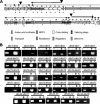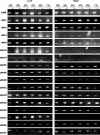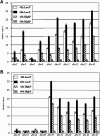Phosphate-controlled regulator for the biosynthesis of the dalbavancin precursor A40926
- PMID: 17873036
- PMCID: PMC2168674
- DOI: 10.1128/JB.01247-07
Phosphate-controlled regulator for the biosynthesis of the dalbavancin precursor A40926
Abstract
The actinomycete Nonomuraea sp. strain ATCC 39727 produces the glycopeptide A40926, the precursor of the novel antibiotic dalbavancin. Previous studies have shown that phosphate limitation results in enhanced A40926 production. The A40926 biosynthetic gene (dbv) cluster, which consists of 37 genes, encodes two putative regulators, Dbv3 and Dbv4, as well as the response regulator (Dbv6) and the sensor-kinase (Dbv22) of a putative two-component system. Reverse transcription-PCR (RT-PCR) and real-time RT-PCR analysis revealed that the dbv14-dbv8 and the dbv30-dbv35 operons, as well as dbv4, were negatively influenced by phosphate. Dbv4 shows a putative helix-turn-helix DNA-binding motif and shares sequence similarity with StrR, the transcriptional activator of streptomycin biosynthesis in Streptomyces griseus. Dbv4 was expressed in Escherichia coli as an N-terminal His(6)-tagged protein. The purified protein bound the dbv14 and dbv30 upstream regions but not the region preceding dbv4. Bbr, a Dbv4 ortholog from the gene cluster for the synthesis of the glycopeptide balhimycin, also bound to the dbv14 and dbv30 upstream regions, while Dbv4 bound appropriate regions from the balhimycin cluster. Our results provide new insights into the regulation of glycopeptide antibiotics, indicating that the phosphate-controlled regulator Dbv4 governs two key steps in A40926 biosynthesis: the biosynthesis of the nonproteinogenic amino acid 3,5-dihydroxyphenylglycine and critical tailoring reactions on the heptapeptide backbone.
Figures







References
-
- Asturias, J. A., P. Liras, and J. F. Martin. 1990. Phosphate control of pabS gene transcription during candicidin biosynthesis. Gene 93:79-84. - PubMed
-
- Bischoff, D., B. Bister, M. Bertazzo, V. Pfeifer, E. Stegmann, G. J. Nicholson, S. Keller, S. Pelzer, W. Wohlleben, and R. D. Sussmuth. 2005. The biosynthesis of vancomycin-type glycopeptide antibiotics: a model for oxidative side chain cross-linking by oxygenases coupled to the action of peptide synthetases. Chembiochem 6:267-272. - PubMed
-
- Candiani, G., M. Abbondi, M. Borgonovi, G. Romano, and F. Parenti. 1999. In-vitro and in-vivo antibacterial activity of BI 397, a new semi-synthetic glycopeptide antibiotic. J. Antimicrob. Chemother. 44:179-192. - PubMed
Publication types
MeSH terms
Substances
LinkOut - more resources
Full Text Sources

